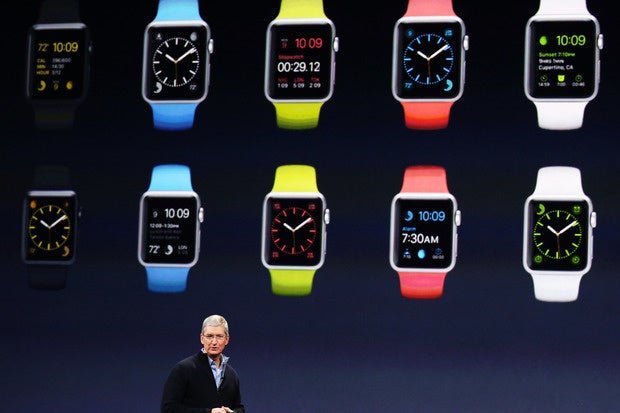Today, I was set to write about the FCC’s recent posting of its Net neutrality laws/guidelines/timid suggestions, but it occurred to me I'd have to download and read all 400 pages of the decision -- probably remember some of it too. That’s a lot to ask of me on a Monday. Besides, I won’t much care anyway until we see the tattered, smoking, blood-stained, bullet-riddled revision that limps out of the first few courtroom battles against Verizon’s radioactive, demon-studded legal team. Instead, I’ll write about how much I hate the Apple Watch because there’s surprisingly little on that -- I mean, surprisingly little.
That’s strange to me because the Apple Watch is quite obviously the tippy-top pinnacle of mind-control advertising straddling a gut-wrenching nadir of blind gadget trendiness. I hope I’m not coming across as too soft or wishy-washy. To be clear: I hate it. The only worse news would be if Apple infected every box with the zombie virus, though that would at least make it a smidge interesting.

Because I loosely qualify as a journalist, mostly due to booze intake, I was schooled to prep for the Grand Coming of the Apple Watch -- an event expected to have about the same impact on human history as the Magna Carta. To ready for its arrival, we in the Whiskey Estate were supposed to be familiar with its technology origins (obvious), its final design (mysterious), and its creator (mind-bogglingly rich and supernaturally talented in marketing).
All eyes on Ive
But even during the carefully orchestrated “leaks” around its release, the Apple Watch seemed in no way new, yet its oomph only increased as the debut drew near, which had me thinking I was missing something important. I wasn’t -- chasing details on its creator, I was suckered into reading a 17,000-word bio on Apple design chief Jon Ive, a sudden powerhouse in Cupertino because he’s credited with inventing not only the iPad and the iPhone, but also a tasty 350-calorie chicken alfredo recipe.
Imagine 17,000 words on Ive’s hopes, his charming shyness, his chauffeured commutes, his pearls of corporate wizard-speak, and all the pomp and high arcana associated with allowing a reporter into the ultrasecret letdown that is the Apple design labs. That’s 17,000 words' worth of me rolling my eyes and whipping ice cubes at Maginot only to finally catch a glimpse of Ive’s mental masterpiece earlier this week wherein we find -- ta-da -- a Nano watch! Cue the polka music and party favors!
The next Nano
I had one of these things in 2009! Different watch faces? Had it with the Nano. Superficial health monitoring? Had it with the Nano. Photos, music, calendar? Had it with the Nano. Inflated price tag? Had it with the Nano -- though the A-Watch is in a league of its own here.
Perhaps in my codgerdom, I’m being too hard on the A-Watch. It is more than a Nano, which didn't have real connectivity or the horsepower to run iOS. Theoretically, this thing should be the sliced bread of bees’ knees, the secret sauce on the cat’s pajamas. The proof in the pudding would come from what you could do with the device -- besides swap back and forth between freshly downloaded Mickey Mouse and Goofy watch faces.
Apps take a backseat
But judging by the apps showcased at the launch event, Apple pushed the “what will they do with it” question to the bottom of the design agenda, right after “blister-pack texture.” Taking a page out of the same book that killed Windows RT, Apple decided to let its ecosystem of third-party app makers come up with why we should buy the thing. Unfortunately, RT app makers and iOS app makers had pretty much the same idea: Take the apps they’re building for the parent device and shrink them down for a smaller screen, whether or not it's useful in any way (spoiler alert: generally not).
Of the 10 “early business” apps listed for the A-Watch, we have five SMS-style chat/notifiers, one task/reminder, two note-reading/taking, one email reading, and two time trackers. To recap: six apps that are both easier to use and more effective on your iPhone, one total fantasy (I will never read presentation notes off my watch), and two that offer me the ability to pay extra for apps that let me, er, tell time ... on a watch. If this thing takes off, my mom, Bill, Elon, and Steve will eventually be proven correct: Artificial intelligence will wipe us off the map, but only because gadgets like this will have devolved our brains into mushroom status and the AIs view it as mercy killing.
What’s really sad is many of us stopped wearing watches because smartphones took over the functionality. Yay, we had one fewer item to carry around or lose. But thanks to tech trendiness, a device we no longer need is coming back, and it's doubling down on the same functions as the device that replaced it -- but not all of them, not as well, and with an emphasis on squinting. And we have it all for the bargain price of $1,000 and our souls.
Insanity, consider yourself redefined.
courtesy:-infoworld
